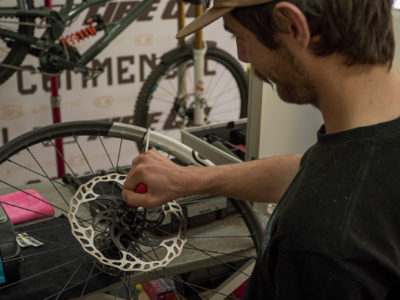Keeping your bicycle’s brake discs in perfect condition is not complicated, but it does require consistency and following some basic tips you can easily apply yourself. Below, we present practical recommendations that will help you maximize the lifespan of your discs and maintain safe and efficient braking.
1. Regular and proper cleaning
Dirt build-up on brake discs not only reduces performance but also significantly accelerates wear. Frequent and proper cleaning is key to keeping them in optimal condition.
Always use specific brake cleaners (Brake Cleaner Galfer ref. 95998A02). These products quickly remove oil, dust, and mud residues without leaving greasy deposits.
Apply it directly to the disc and brake pads, always avoiding contact with hydraulic seals or rubber parts. Also, use a clean microfiber cloth or absorbent paper to dry and remove any residue after application.
Finally, never use lubricants or generic cleaners that may contain oils or silicones, as this could contaminate the discs and compromise braking ability.
To prevent dirt or oil build-up, perform this quick cleaning after every ride in dusty, wet, or muddy conditions.
Avoid touching the disc surface with your fingers or greasy tools, and regularly check for hydraulic brake fluid leaks, as these can quickly contaminate both discs and pads.
2. Correct pad choice for your riding style
Choosing the right brake pads directly affects disc durability. Not all pads are the same, and selecting the right ones for your riding style and bike type will help optimize braking performance and extend disc life. Galfer brake pads are semi-metallic with a high percentage of organic materials, which helps increase disc lifespan.
How does pad compound affect disc wear? Organic pads are softer, quieter, and provide smoother braking—ideal for less aggressive riding like XC or urban use.
However, they tend to wear faster in wet conditions and may need more frequent replacement.
Sintered (metallic) pads are more durable and resistant to high temperatures, making them ideal for aggressive disciplines like Enduro or Downhill. The trade-off is greater disc wear due to hardness, although braking performance is excellent in demanding conditions.
Galfer semi-metallic brake pads combine the best of both compound types, offering powerful, quiet, and long-lasting braking, with six different compounds available depending on rider needs.
Choosing the right pads for your riding style and keeping the braking system clean are key actions that will make a difference in disc lifespan. Put these tips into practice and you’ll quickly notice the results!
Common mistakes that accelerate disc wear
Although brake disc maintenance is relatively simple, there are common mistakes many cyclists make without realizing it, which can drastically shorten component life. Knowing these errors will help you avoid them easily, ensuring safe, efficient braking every ride.
Incorrect use of cleaners or lubricants
One of the most common mistakes is using the wrong products during maintenance. Brake discs must remain completely free of grease, oils, or any contaminating substances.
- Frequent mistake: using generic lubricants, multipurpose oils, or WD-40 directly on discs or pads.
- Consequence: these products contaminate the braking surface, drastically reduce effectiveness, and accelerate disc wear.
- Recommended solution: use only specific brake cleaners (Brake Cleaner Galfer ref. 95998A02) that remove dirt without leaving residues.
Incorrect component installation
Another common mistake causing premature wear is incorrect assembly of braking components. This happens especially when users change discs or adjust calipers without following proper instructions.
- Frequent mistakes:
- Uneven or excessive tightening of disc bolts, causing warping.
- Installing new discs without ensuring correct caliper alignment, leading to constant rubbing.
- Uneven or excessive tightening of disc bolts, causing warping.
- Consequence: these errors cause uneven wear distribution, increasing chances of warping, vibration, and brake overheating.
- Recommended solution: always follow manufacturer recommendations and use a torque wrench to ensure correct tightening.
Mixing new pads with worn discs
A very common mistake is installing new brake pads on old or excessively worn discs.
- Frequent mistake: installing new pads without first checking disc condition.
- Consequence: new pads won’t seat properly on excessively worn discs, causing faster deterioration and reduced braking efficiency. It also leads to excessive noise, vibration, and less safe braking.
- Recommended solution: always check disc thickness and overall condition when replacing pads. If the disc is near minimum thickness or visibly damaged (MIN. TH.), replace it at the same time as the pads to ensure optimal performance. Galfer discs have a minimum recommended thickness of 0.5 mm below their original. For 1.8 mm discs, replacement is required at 1.3 mm; for 2.0 mm discs, replacement at 1.5 mm.
Avoiding these common mistakes will help significantly extend the lifespan of your bike’s brake discs, ensuring safe, reliable, and efficient braking on all your rides.
When is it essential to replace discs?
Knowing exactly when to replace your bicycle’s brake discs is key to maintaining optimal performance and ensuring safety. While regular maintenance extends disc lifespan, replacement eventually becomes essential.
Here’s a quick visual checklist of the definitive signs that it’s time to replace your brake discs:
| Warning sign | What it means | Action required |
| Thickness below minimum recommended (usually 1.3–1.5 mm) | Disc is no longer safe or effective, may cause brake failure. | Immediate replacement |
| Visible disc deformation (warping or bending) | Causes vibration, noise, and irregular braking, increasing accident risk. | Immediate replacement |
| Deep scratches or visible surface damage | Drastically reduces braking capacity and accelerates pad wear. | Immediate replacement |
Minimum thickness: If a caliper measurement shows the braking track is below the manufacturer’s minimum, replace immediately. A thin disc loses strength and effectiveness, compromising safety. Always check different points across the braking track.
Visible deformation (warping): If, when spinning the wheel, the disc wobbles or moves irregularly sideways, it’s deformed. This severely affects braking efficiency and may damage other components.
Deep scratches or visible damage: Deep grooves or cracks are clear signs of irreversible damage that affect braking performance. They can also cause noise and speed up pad wear.
Remember, don’t delay replacement when these signs appear. Replacing discs on time is essential for keeping your bike safe, reliable, and efficient at all times.
Caring for brake discs is one of the simplest and most effective actions to improve safety, save on maintenance, and extend braking system life.
By applying practical tips like proper cleaning, choosing the right pads, and avoiding common mistakes, you’ll keep your discs in top shape for longer. Also, recognizing wear signs early allows you to act before performance is affected. Remember: small maintenance habits make a big difference on the road or trail.

